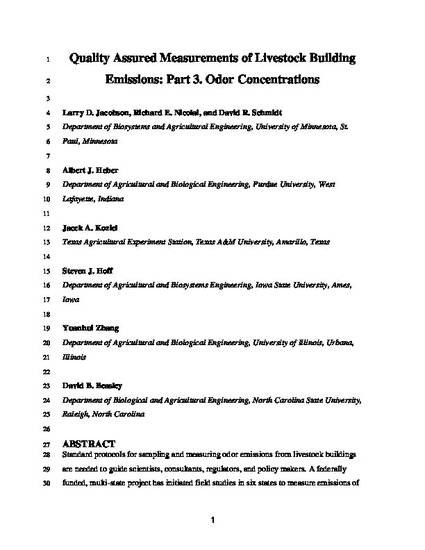
Standard protocols for sampling and measuring odor emissions from livestock buildings are needed to guide scientists, consultants, regulators, and policy-makers. A federally funded, multistate project has conducted field studies in six states to measure emissions of odor, coarse particulate matter (PM10), total suspended particulates, hydrogen sulfide, ammonia, and carbon dioxide from swine and poultry production buildings. The focus of this paper is on the intermittent measurement of odor concentrations at nearly identical pairs of buildings in each state and on protocols to minimize variations in these measurements. Air was collected from pig and poultry barns in small (10 L) Tedlar bags through a gas sampling system located in an instrument trailer housing gas and dust analyzers. The samples were analyzed within 30 hr by a dynamic dilution forced-choice olfactometer (a dilution apparatus). The olfactometers (AC’SCENT International Olfactometer, St. Croix Sensory, Inc.) used by all participating laboratories meet the olfactometry standards (American Society for Testing and Materials and European Committee for Standardization [CEN]) in the United States and Europe. Trained panelists (four to eight) at each laboratory measured odor concentrations (dilution to thresholds [DT]) from the bag samples. Odor emissions were calculated by multiplying odor concentration differences between inlet and outlet air by standardized (20 °C and 1 atm) building airflow rates.
Available at: http://works.bepress.com/steven_hoff/157/

This is an Accepted Manuscript of an article published by Taylor & Francis as Jacobson, Larry D., Brian P. Hetchler, David R. Schmidt, Richard E. Nicolai, Albert J. Heber, Ji-Qin Ni, Steven J. Hoff et al. "Quality assured measurements of animal building emissions: Odor concentrations." Journal of the Air & Waste Management Association 58, no. 6 (2008): 806-811.. Available online DOI: 10.3155/1047-3289.58.6.806. Posted with permission.